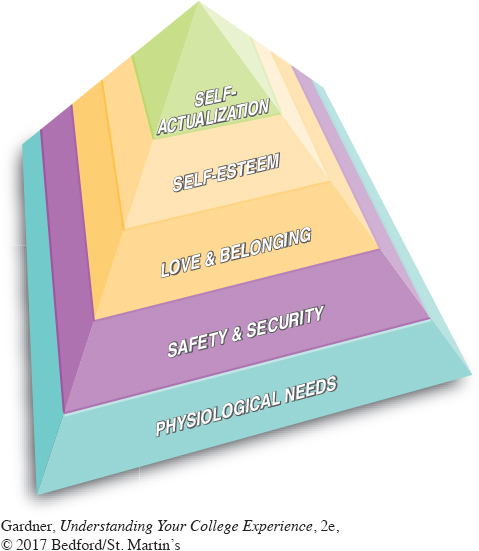4.1 HOW PEOPLE LEARN
People learn differently, and understanding how the brain functions helps explain why. An entire field of study called neuroscience focuses on the brain. Neuroscientists and psychologists have developed many theories about how and why people learn differently. Some of the many theories about learning are relevant for college students, especially first-year students.
Learning Theories
One of the most well-known learning theories comes from Abraham Maslow, a psychologist.1 Using Maslow’s “hierarchy of needs,” one might logically argue that in order for students to learn, their needs must be met—basic needs such as food, water, and shelter; safety and security needs such as employment and property; needs for love and belonging; needs for self-esteem that comes from achievement, and self-actualization that can be reached through having a purpose and meeting your potential. You probably have found that when you’re hungry, fearful, or lonely, it is very hard—nearly impossible—to learn effectively. If your basic needs are met, you develop friendships, and you experience success, it becomes easier to focus on your courses and continue to learn.

Albert Bandura, a psychological researcher, developed a theory of social learning, which suggests that people learn from each other by observing others’ actions and the results of those actions.2 These observations help them repeat or avoid certain attitudes and behaviors. If you had older brothers and sisters, you probably observed their interactions in the family and learned how to stay out of trouble with your parents. In college you will observe other students—those who are successful and those who are not. If you pay attention, you can figure out what behaviors actually lead to success. It’s not just about “being smart.” Successful students come to class, spend time studying, interact with instructors, and take advantage of the academic support available on campus.
In her work on how adult students learn, Nancy Schlossberg, a counseling psychologist, developed a theory of transition.3 She found that adults learn new roles when they go through change or transition in their lives. As adults, we constantly change our roles; for example, we change from being a high school student to a college student, from a college student to an employee, or from an employee to a college student. Often we juggle multiple roles at the same time. We also experience changes in our personal roles when we get married or divorced or have children. The transition theory states that change actually helps adults grow and learn new ways of thinking and behaving. During the transition process, the more help and support we receive from people around us, the more easily we will adapt to change. For example, college students who ask for help from their instructors, classmates, tutors, advisers, and even their families and friends can make a more successful transition to college life and deal with the challenges of a new environment more effectively than students who do not seek such assistance.
Learning Styles
In addition to looking at theories about learning, we can think about how people learn by focusing on personal learning styles. Simply put, learning styles are ways of learning. Through work and other prior experience, you may have some sense of how you like or don’t like to learn. At the start of the chapter, we asked you to consider how you learn best: listening in lectures, reading your textbooks, doing experiments in science labs, working in groups, and so on. These “preferences” that you have relate to your learning style. Researchers have developed formal methods and tools—some are simple, and some are complex—to identify, describe, and understand the different learning preferences. These tools help students learn to adapt their learning styles to different classroom situations. Remember, it is your responsibility to take charge of your learning in order to be successful in college.
In this chapter, we introduce three of the most commonly used tools and theories for understanding learning styles. They all can help you to begin discovering your own learning style and strategies for improving your learning. These are the VARK Learning Styles Inventory, the Myers−Briggs Type Indicator, and Multiple Intelligences. As you are making these discoveries, keep in mind that your learning style cannot be boiled down to one or two defining characteristics, especially given that learning styles are complex and can vary based on content and context. But the knowledge you will gain about yourself from working through this chapter is a significant step in taking responsibility for your learning.